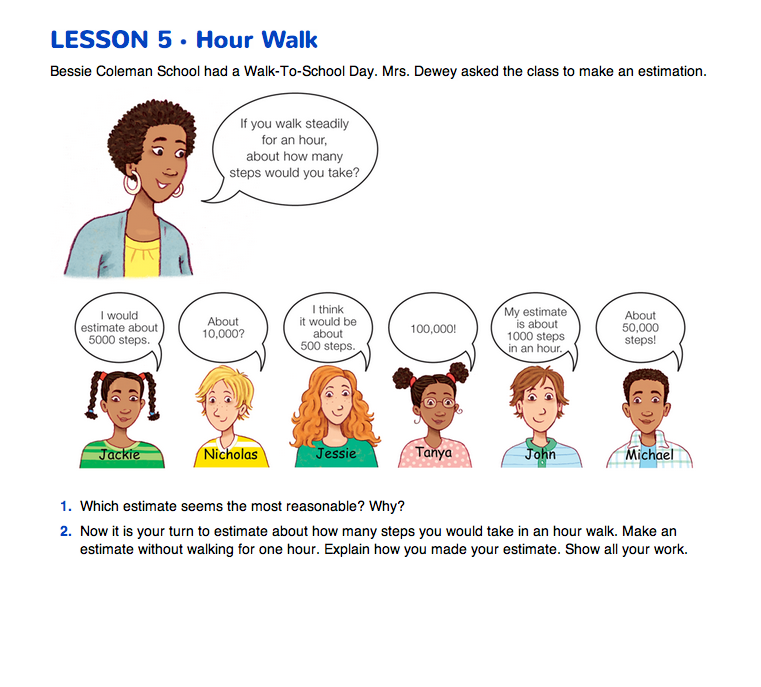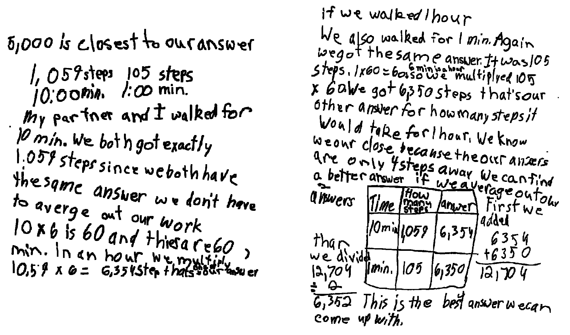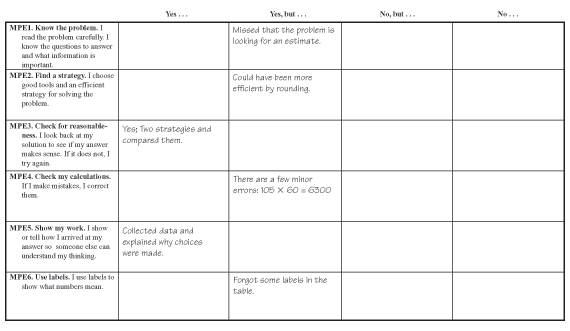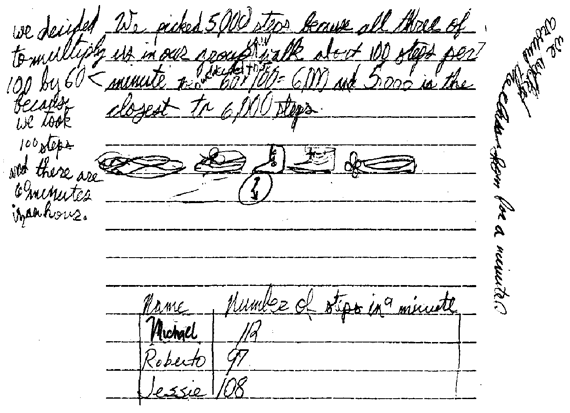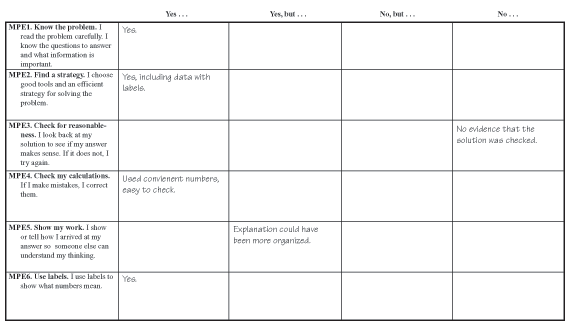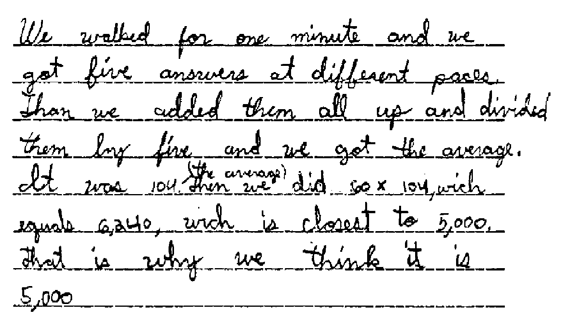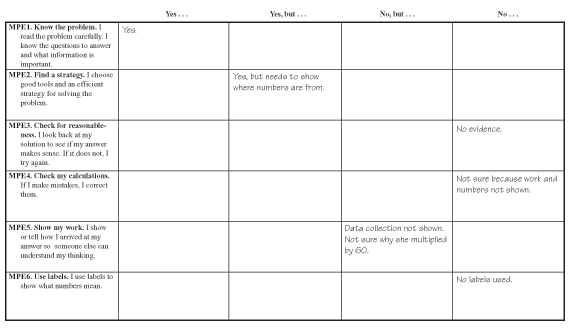Launch and Solve the Problem. Launch the lesson by reading the vignette on the Hour Walk pages in the Student Guide. Ask students to think about the estimates offered by the students in Mrs. Dewey's class and decide which estimate is most reasonable and why. Direct students to share their ideas with a partner as you distribute the Hour Walk Work Assessment Master.
- What tools or information will you need to be able to solve this problem?
Discuss and record student responses on the board. Students might ask for a stopwatch or use a class clock with a second hand. Students may need to be reminded of the number of minutes in one hour. Based on previous work, students might also want Centimeter Graph Paper, which you can make available by making copies with the Master.
Organize students into groups of three or four students. This works well since they will need to collect data to solve the problem. Ask students to work with their groups to come up with a plan for solving the problem. Tell students to record their plans on chart paper to share later and to support writing their own explanations. Once a group has agreed on a plan, they solve the problem together.
Getting to Know the Problem. Some students may need additional support to get started on the problem. Below are some questions that can give them a jumpstart. Make note of additional support you provide.
- What is the problem in your own words? (Estimate the number of steps I would take in 1 hour.)
- How do you think you should start?
- How many steps do you take in one minute?
- Do you think you would take the exact same number of steps if you walked for another minute? Close to the same number?
- How many steps do you take in five minutes?
- How can you use that information to find the answer?
Explain How You Solved the Problem. Ask students to write their solutions individually or in groups. Remind them to refer to the Math Practices page in the Reference section of the Student Guide. Provide time for students to talk about the problem and their solutions before they begin writing. See the Meeting Individual Needs box for strategies you can use to get students talking about their problem solutions. If students report in groups, recording on chart paper will work well. Students talk through their solutions as they create a poster which allows for easy sharing later.
Use Math Practices Notes. Choose one or two pieces of student work to review with the class. Choose either work from your own students or from the sample responses provided as Masters in this lesson. It is usually more useful to discuss work from your own class, but you may decide to use the sample work provided. Display the appropriate Master.
Ask students to look at the Math Practices page in the Reference section of their Student Guides. Use a display of the Math Practices Notes Master to record the class's suggestions for meeting the Expectations when solving and writing up this particular problem. Entries should be specific to this problem. See Figure 1.
After Expectations have been discussed, give students time to revise their individual or group work.

Talking about Problem Solutions. All students need to talk about their solutions before putting them in writing or some other published form. Talking about their solutions helps them organize their ideas. Provide opportunities for students to talk through problems, especially those involving multiple steps like this problem.
There are several strategies you can use to get students to talk through their solutions before writing them down. One way to meet individual needs is to vary the way students report their solutions. Some students are prepared to record their solutions in writing. For others, the writing is an obstacle, but their solutions should still be shared in some way. Below are some strategies for varying the product or supporting students before they record their solutions in writing.
- Ask students to report to another group how they solved the problem. Then have them record what they reported in writing or using other media, such as a video recorder.
- Ask students to record explanations on a video-recording device. Students can then record their work in writing as they play these back. The video-recorded explanations can be made available for others to review and evaluate.
- Have students display their solutions on large pieces of chart paper for others to see. Students discuss the problem during the creation of the poster and their work becomes easily accessible for others to review and evaluate.
- Have each student group explain their solution to you or a classroom helper before they start to write their explanation. Ask clarifying questions and encourage students to describe what the numbers mean in the context of the problem.
Review Keenya's Work. Use the following suggested discussion prompts and Figure 2 to review Keenya's Work. Figure 3 shows feedback students might give Keenya on the Hour Walk Work Feedback Box.
- What did Keeya do to solve this problem? (Keenya and her partner counted the steps in 10 minutes and in 1 minute. They then calculated the steps in 1 hour. They solved the problem two ways and compared them. They averaged the solutions from each of these strategies.)
- How do you know Keenya and her partner read the problem carefully? (They identified most of the important elements of the problem but missed that it asked for an estimate, not an exact answer.)
- Did Keenya choose a good and efficient strategy? (Using rounded numbers would have been more efficient.)
- Did she keep working on the problem until she found a reasonable solution? (Yes, and she described how she solved the problem two ways and compared her answers.)
- Did she check her calculations? (There are a few minor errors.)
- Did Keenya show or tell how she arrived at an answer? (Her explanation and choices are clearly stated and organized. We know she solved the problem two ways to verify her answer, why she averaged the two solutions in the end, and what data was collected and how.)
- Did she use appropriate labels? (Most of the time. Her table lacks labels.)

Some simple suggestions to help students revise their work:
- Choose one Expectation to fix.
- Label all your numbers.
- Use number sentences with words to help describe what you did (e.g., the number of steps in 1 minute X the number of minutes in 1 hour = number of steps in 1 hour).
- In four sentences, tell what you did.
- Tell how you looked back to see if your answer is reasonable.
Review Michael's Work. Use Figure 4 and discussion prompts similar to the following to review Michael's Work. Figure 5 shows feedback students might give Michael on the Hour Walk Work Feedback Box.
- How did Michael solve this problem? (Michael found the number of steps each member of the group walked in one minute and organized their work in a data table. Michael looked at the data and determined that they each walked about 100 steps. He then multiplied 100 steps in 1 minute by 60 minutes in 1 hour and got 6000 steps in one hour.)
- Did Michael read the problem carefully? (Michael identified the important parts of the problem. He estimated the number of steps in 1 hour and identified the important variables in the problem and showed them in his drawing.)
- Did Michael choose a good and efficient strategy? (Yes. Michael used multiple trials and multiplied using convenient numbers.)
- Did he look back to see if his solution was reasonable? (There is no evidence that he looked back at his work to check the reasonableness of the results.)
- Did he check his calculations? (Since he used convenient numbers, his calculations are easy to verify and they are accurate.)
- Did Michael show or tell how he arrived at an answer? (Yes, his explanation is all there, but difficult to follow because it is not organized.)
- Did he use appropriate labels? (Numbers and parts of the problem are labeled appropriately.)
- Michael has some improvements to make. What suggestions do you have for Michael? (Organize his solution so it is easier to follow; number the different steps he took; show or tell how he checked his answer for reasonableness.)
Review Grace's Work. Use the following suggested discussion prompts and Figure 6 to review Grace's Work. Figure 7 shows feedback students might give Grace on the Hour Walk Work Feedback Box.
- What did Grace do to solve this problem? (She counted steps in one minute using five different paces and then found the mean. She multiplied by 60 to get 6240. She did not explain why she multiplied by 60 and did not display the data she collected. She did not explain why she rounded 6240 to 5000 instead of 6000.)
- Did Grace read the problem carefully? (She identified the major parts of the problem, devised a plan, and carried it out.)
- Did Grace choose a good and efficient strategy? (She chose appropriate operations and procedures: taking five trials, averaging, multiplying, and estimating.)
- Did she keep working on the problem until she found a reasonable solution? (We're not sure. Grace did not record the data she collected, so we cannot tell if her answer is reasonable. There is no evidence that she checked her answer for reasonableness.)
- Did she check her calculations? (We're not sure because she did not show the data used to get the answer.)
- Did Grace show or tell how she arrived at an answer? (She did not explain why she multiplied by 60 or show the data she collected.)
- Did she use appropriate labels? (She did not label her numbers.)
- What can Grace do to improve her explanation? What revisions do you recommend? (She should include the data for the five trials, tell why she multiplied by 60, add labels to all the numbers, show how she checked the answer for reasonableness.)
Give Feedback. Ask groups to display the solutions they wrote on chart paper around the room. Ask each student to remove the Hour Walk Work Feedback Box pages from the Student Activity Book. Tell students that, with a partner, they will visit two of the posters hanging around the room. Together, students will provide feedback to their classmates and in turn will receive feedback from their classmates. Partners should record feedback together on the Student-to-Student section of the Hour Walk Work Feedback Box page. Give students time to share their comments with the student whose work was reviewed.
While students are sharing, look for interesting solutions that can be discussed during Summarizing the Lesson.
You can make this feedback as structured as you choose. Students can circulate and make their own choices about which student work to review or you can group students so that they provide and receive feedback to and from each other.
There are many ways to provide feedback to students. To be useful, it must be specific and connected to the Expectations. Verbal feedback is probably the most useful and effective feedback. However, classroom realities sometimes prevent teachers from being able to provide verbal feedback to each student or group of students, so feedback from peers is another good source.
Written feedback can also be effective if it is specific and related to the Expectations. The Hour Walk Work Feedback Box page in the Student Activity Book provides a place to make notes about how students are doing and to note questions you might have in relation to specific Expectations.














